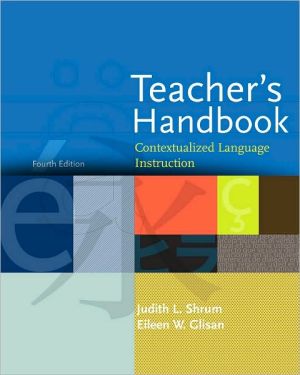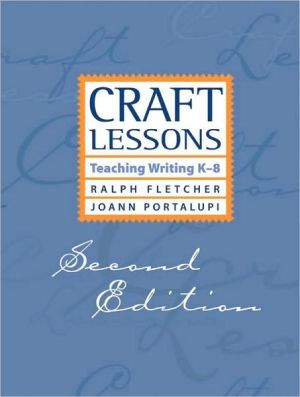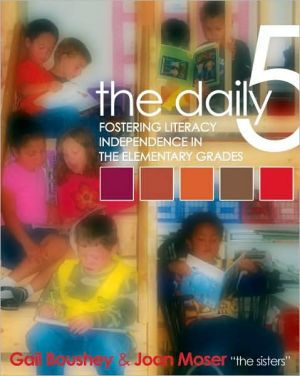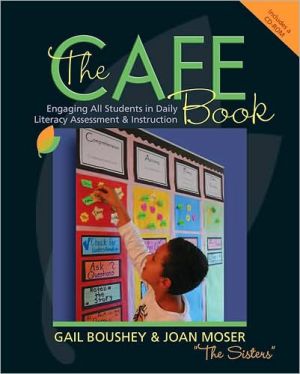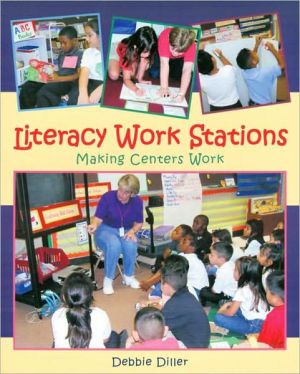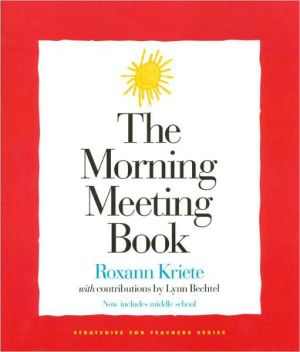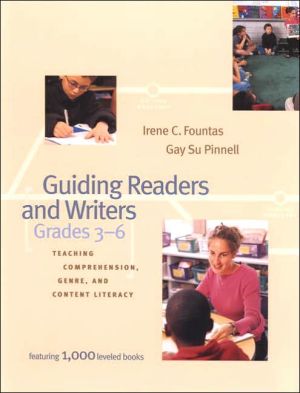Teacher's Handbook
Teach foreign language effectively with TEACHER'S HANDBOOK: CONTEXTUALIZED LANGUAGE INSTRUCTION, 4th Edition. Designed to prepare you to teach foreign language, this handbook incorporates the Standards for Foreign Language Learning in the 21st Century, and provides a practical framework for integrating the Five C's into foreign language teaching. Mastering the material is easy with real-world examples, provocative case studies, extensive appendices, and a text-specific website with links to...
Search in google:
Teach foreign language effectively with TEACHER'S HANDBOOK: CONTEXTUALIZED LANGUAGE INSTRUCTION, 4th Edition. Designed to prepare you to teach foreign language, this handbook incorporates the Standards for Foreign Language Learning in the 21st Century, and provides a practical framework for integrating the Five C's into foreign language teaching. Mastering the material is easy with real-world examples, provocative case studies, extensive appendices, and a text-specific website with links to teacher resources and streaming video of standards-based instruction.
TABLE OF CONTENTS: ACKNOWLEDGEMENTS. PREFACE. PRELIMINARY: BECOMING FAMILIAR WITH THE PROFESSION AND EXPECTATIONS FOR LANGUAGE TEACHERS. Architecture of the Profession. Expectations for Language Teachers: A Continuum of Teacher Standards. Language Policy and Language Education Policy. Investigate and Reflect: Learning About Your National Language-Specific Organization and Your state Language Association. Learning About Your Regional Language Conference. Familiarizing Yourself With Foreign Language Resources. Comparing Teacher Standards Across the Career Continuum. Language Policy and Language Education Policy. 1. UNDERSTANDING THE ROLD OF CONTEXTUALIZED INPUT, OUTPUT AND INTERACTION IN LANGUAGE LEARNING. Conceptual Orientation: Language Learning as an Individual (Cognitive) Achievement. Language Learning as a Collaborative (Social) Achievement. The Role of affect and Motivation. Implications of the Research for Classroom Teaching. Observe and Reflect: Observing a Child Interacting in His/Her Native Language (L1). Alternative Observation of a Child Interacting in His/Her Native Language (L1). Observing a Beginning Language (L2) Class. Discuss and Reflect: Creating Real Conversational Models. 2. CONTEXTUALIZING LANGUAGE INSTRUCTION TO ADDRESS GOALS OF THE STANDARDS FOR FOREIGN LANGUAGE LEARNING. Conceptual Orientation: A Historical View of Context in Foreign Language Instruction. The Role of Context in Proficiency-Oriented Instruction. An Introduction to the Standards for Foreign Language Learning in the 21st Century (SFLL). Focus on Context: The Weave" of Curricular Elements. Pre K-12 English Language Proficiency Standards: Using the Standards Framework to "Contextualize" the Curriculum. Teach and Reflect: Developing a Learning Scenario. Contextualizing the Teaching of a Past Tense Grammar Point. Using the Standards at the Post-Secondary level. Discuss and reflect: Teachers Talking Textbooks. 3. ORGANIZING CONTENT AND PLANNING FOR INTEGRATGED LANGUAGE INSTRUCTION. Conceptual Orientation: Current Paradigm for Instructional Planning. Planning for Student Learning and the Development of Thinking Skills. Considerations in Providing Input and Selecting Content. Classroom Discourse: Teacher Feedback vs. Evaluation. Long-Term Planning for Instruction. Daily Lesson Planning. Teach and reflect: Planning for Instruction. Developing a Content-Based Level 5 Foreign Language Class. Comparing State Framework and Curriculum Documents. Exploring Options for CBI at the Post-Secondary Level. Discuss and Reflect: Analyzing the Use of Content and context in a Japanese Lesson. 4. CONNECTING LANGUAGE LEARNING TO THE ELEMENTARY SCHOOL CURRICULUM. Conceptual Orientation: An Optimal Age for Language Acquisition? The Elementary School Learner. Program Models. Traditional FLES Programs of the Past and Early Language Programs of the Present. Strategies for Teaching Language to Elementary School Learners. Standards Highlight: Making Connections Between Language and the Elementary School Curriculum. Teach and Reflect: Designing a Content-Based Elementary School Lesson. Developing a Storytelling Lesson. Discuss and Reflect: Teaching Fourth-Grade Content in French. 5. INTEGRATING CULTURES AND COMPARISONS IN MIDDLE SCHOOL LANGUAGE INSTRUCTION. Conceptual Orientation: The Middle Level Learner. Language Instruction in the Middle School. Principles for Middle School Language Instruction. Standards Highlight: Integrating Cultures and Comparisons into Middle School Language Instruction. Assessment of Middle School Performance. Teach and Reflect: Developing Culture-Specific Examples of the Three Ps. Unit and Lesson Design Around a Story, Myth, or Folktale. Viewing and Analyzing Lessons on the Three Ps. Discuss and Reflect: It's McLicious! Staying in the Target Language. 6. USING AN INTERACTIVE APPROACH TO DEVELOP INTERPRETIVE COMMUNICATION. Conceptual Orientation: Framework of Communicative Modes. Standards Highlight: Exploring the Interpretive Mode Through Listening, Reading, Viewing. Interpretive Communication: Listening and reading Processes. The Viewing Process. Research on the Variables Involved in Comprehension and Interpretation. Integration of Authentic Texts. The Role of the Interpretive Mode Across Instructional Levels. An Interactive Model for Integrating the Three Modes of Communication. Teach and Reflect: Using the Interactive Model to Explore an Authentic Printed Text. Using the Interactive Model to Explore an Authentic Audio/Video Segment. Teaching Literature at the Post-Secondary Level. Discuss and Reflect: Reading Aloud. 7. USING A STORY-BASED APPROACH TO TEACH GRAMMER Conceptual Orientation: The Deductive and Inductive Dichotomy. Reconceptualizing Grammar Instruction. Basic Principles of Dialogic Story-Based Language Teaching. A Model for Dialoguing about Form in a Story-Based Language Approach. Elements of Story-Based Language Learning. Voices of the Learners. Teach and Reflect: Examining Grammar Presentations in Textbooks. Designing a Story-Based PACE Lesson. Developing a PACE Lesson for the Post-Secondary Level. Discuss and Reflect: Contrasting Explanations of Form. 8. DEVELOPING ORAL AND WRITTEN INTERPERSONAL COMMUNICATION. Conceptual Orientation: Interpersonal Speaking from a Proficiency Perspective. Standards Highlight: Exploring the Interpersonal Mode Through Speaking and Writing. Strategies for Teaching Interpersonal Speaking. Teacher Interaction with Students. Teaching Strategies for Group Interaction. Student Interaction. Developing Interpersonal Speaking Through Study of Literature and Culture. Teaching Interpersonal Writing. Providing Feedback in Oral Interpersonal Contexts. Teach and Reflect: Creating Information-Gap Activities for Various Levels of Instruction. Integrating Speaking Tasks with Oral or Printed Texts. Integrating Advanced-Level Discourse at the Post-Secondary Level. Discuss and Reflect: "Survivor" Game: Keeping Students in the Target Language. 9. DEVELOPING ORAL AND WRITTEN PRESENTATIONAL COMMUNICATION. Conceptual Orientation: Standards Highlight: Exploring the Presentational Mode Through Speaking and Writing. The Nature of Oral and Written Presentational Communication. Presentational Communication: L1 vs. L2. Research on Teaching Presentational Writing. Teaching Presentational Writing and Speaking as a Process. Presentational Writing as Product: ACTFL Proficiency Guidelines - Writing. Formats for Presentational Communication in the Classroom. Responding to Presentational Writing. Responding to Oral and Multimedia Presentations. Teach and Reflect: Designing a Presentational Process-Oriented Writing Activity for Secondary Levels or Beyond. Finding the Oral and Written Presentational elements in Prepared Project Units. Discuss and Reflect: Integrating Peer Revision into the Presentational Writing Process. 10. ADDRESSING DIVERSE NEEDS OF LEARNERS IN THE LANGUAGE CLASSROOM. Conceptual Orientation: The Diverse Ways in Which Learners Approach Language Learning. Teachers' Personality Types and Teaching Styles. Addressing Diverse Learner Needs. Addressing Diverse Learner Needs Through Differentiated Instruction. Standards Highlight: Bringing diverse Student Groups Together Through Participation in Multilingual Communities. The Communities Goal Area. Teach and Reflect: designing a Language lesson Appropriate for Diverse Learning Styles. Working Within Communities. Discuss and Reflect: Differentiating Instruction: Three Classrooms. 11. ASSESSING STANDARDS-BASED LANGUAGE PERFORMANCE IN CONTEXT. Conceptual Orientation: Planning for Assessment in a New Paradigm. Purposes of Tests: A Definition of Terms. Assessment Formats: A Definition of Terms. Assessment Formats: Prochievement, Performance-Based, Interactive Model. Authentic and Standards-Based Assessment. Empowering Students Through Assessment. The Oral Proficiency Interview: Implications for Classroom and Program Assessment. Mediating performance: An Introduction to Dynamic Assessment. Planning for Classroom Assessment. Teach and Reflect: Analyzing and Adapting a Traditional Test. Adding an Authentic Dimension to a Performance-Based Assessment Task. Designing an Integrated Performance Assessment (K-16). Discuss and Reflect: Developing Authentic Assessment Tasks and Rubrics. 12. USING TECHNOLOGY TO CONTEXTUALIZE AND INTEGRATE LANGUAGE INSTRUCTION. Conceptual Orientation: Technology Connects the Standards. Multimedia Technology in the Three Modes of Communication. Computer-Mediated Communication (CMC). Empowering Learners Through Web-Enhanced Technologies. What the Future of Technology Holds for Language Learning. Teach and Reflect: Are Your Students Technologically Literate? Helping Students Address the National Educational Technology Standards. Examining the Potential Use of a TELL Exercise. Creating a WebQuest. Discuss and Reflect: Teaching Through Photos. Appendices. Index."
